Ever wondered how your favorite apps and software stay awesome even after countless updates? Picture this: developers are coding furiously, testers are putting their detective hats on, and new features are added left and right.
But with great changes comes great responsibility – ensuring that everything still works like a charm and no sneaky bugs have crept in! That’s where regression testing swoops in to save the day!
In this blog post, we will provide a comprehensive explanation of regression testing, covering its test cases, types, tools, and all the essential information you need to know. Let’s delve right into it!
What is Regression Testing?
Regression testing is a type of testing where you can verify that the changes made in the codebase do not impact the existing software functionality. For example, these code changes could include adding new features, fixing bugs, or updating a current feature.
In other words, regression testing means re-executing test cases that have been cleared in the past against the new version to ensure that the app’s functionalities are working correctly. Moreover, regression testing is a series of tests, not a single one performed whenever you add a new code.
Can Regression Testing Be Performed Manually?
Yes, regression testing can be performed manually. It involves retesting the modified parts of a software application to ensure that the changes haven’t negatively impacted the existing functionalities.
Though manual regression testing is possible, it can be time-consuming and error-prone, especially for large and complex systems. Therefore, automated regression testing tools are recommended to improve efficiency and accuracy.
Regression Testing Example
Let’s say you’re building an image and video editing application. After developing the core features, you perform regression testing with 1000 cases to ensure everything works correctly. Once it passes, you deliver it to the client.
Over time, you realize the application needs new features for enhanced customer satisfaction. You add them, but now you need to re-run regression testing. You create 100 new test cases for the changes and re-run the previous 1000 to ensure the core features function properly.
This is a typical regression testing with real time example. It’s beneficial as it helps catch potential issues with code changes but it requires preparation and effort. Below, we’ll discuss ideal scenarios for performing regression testing.
When to Perform Regression Testing?
Ideally, regression testing should be performed every time changes are made to a system and the code is modified, including adding new features, bug fixes, and performance improvements. It is suitable in scenarios when:
- A new feature or functionality is added to the application
For instance, you have built a website with a login functionality allowing users to log in only via email. And now you add login via Facebook.
- There is a requirement change
For instance, you remove the remember password functionality on the login page which was applicable previously. Regression testing is conducted after every such change.
- When defects in the codebase or patches are fixed
For instance, when a tester reports a broken login button. Once developers fix the bug, the login button is tested for expected results, but simultaneously, tests are also performed for other functionalities related to the login button.
- When performance issues are fixed
For instance, when a page takes 5 seconds to load but the loading time is reduced to 2 seconds.
- When there are environment or configuration changes
For instance, update the database from MySQL to Oracle.
Pros and Cons of Regression Testing
Pros
- Ensures that any change in code doesn’t adversely affect other functionality.
- Makes sure that already fixed issues don’t re-occur.
- Serves as a risk mitigation strategy during testing.
- Easy to learn, understand and analyze.
Cons
- Without automation, regression testing can be time-consuming.
- Need to perform for every small change of code.
- A highly repetitive process may affect the agile sprint.
- Requires you to create complex test cases.
Regression testing is vital for delivering robust products and managing risks, but it can be a cumbersome process. Thus, it’s essential to thoroughly evaluate its pros and cons before making a decision. Let’s explore the challenges associated with regression testing.
Challenges in Regression Testing
The main challenges in regression testing are as follows:
- Test suites grow in size as more regression runs are performed. And the whole regression test suite cannot be run due to time and financial restrictions.
- Decreasing the test suite while attaining maximum test coverage is still difficult.
- Determining the frequency of regression tests, such as after every modification, every build update, or after a slew of issue patches, is not so easy.
How to Conduct Regression Testing?
Generally, there is no fixed pattern for implementing regression testing. However, there are some popular regression testing methods that a QA analyst should keep in mind.
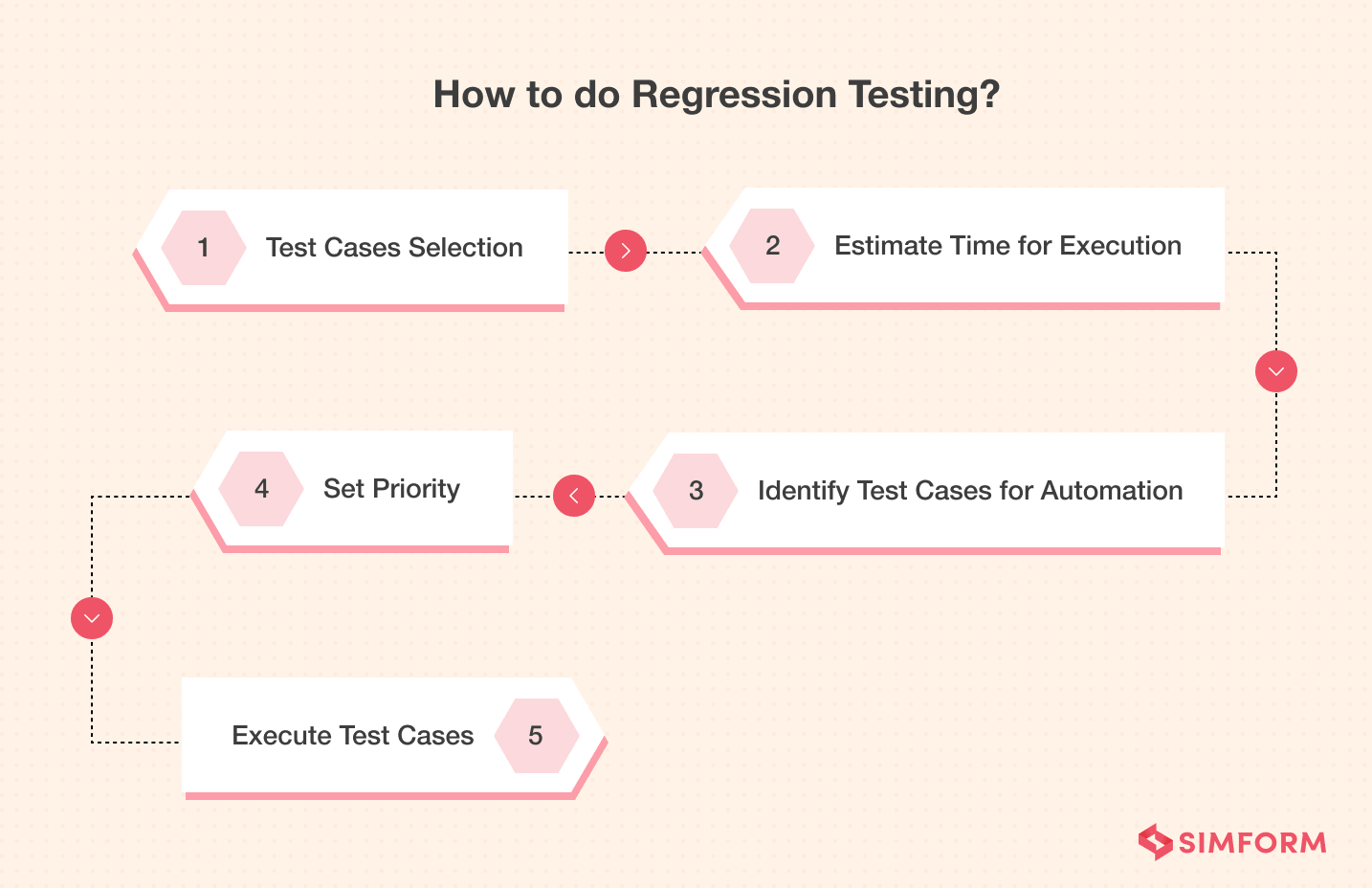
Step 1: Regression Test Selection
As the name suggests, you select the test cases requiring re-testing here. You won’t test the entire test suite, and the selection of test cases will depend on the module where there is a change in the source code.
Finally, you divide the test cases into (i) Reusable Test Cases and (ii) Obsolete Test Cases. Reusable ones will be used for future regression cycles, while you won’t consider Obsolete ones for the upcoming testing cycles.
Here are the tricks to identify the reusable test cases:
- Are highly error-prone
- Verify the functionality of an app
- Contain features that are visible to users
- Have a recent change in the source code
- Have been successfully conducted in the past
- Have failed in earlier testing stages
- Are related to integration
- Are related to boundary-value
Step 2: Determine the Time for Executing Test Cases
The next step is to estimate the time it will take to execute the selected test cases. Few factors that affect the execution time are test data creation, regression test planning by the QA team, review of all test cases, etc.
Step 3: Identify the Test Cases that can be Automated
In this step, based on the results of exploratory testing, the QA team can decide the test cases that they can automate. Automated test cases are faster than manual testing and allow you to re-use the same script repeatedly. So, divide the test cases into two groups – (i) manual test cases and (ii) automated test cases.
Step 4: Test Cases Prioritization
Here, you gather all the test cases and prioritize them, i.e., high, medium, and low. Based on this evaluation, you will execute the high-priority test cases first, followed by medium and low priority test cases. The priority will depend on the product’s functionality and user involvement.
Below is the waterfall structure of priorities:
- Priority 0: The most critical test cases include all the core functionalities.
- Priority 1: Essential features, but not a part of core functionality.
- Priority 2: Test cases related to technical debt.
Step 5: Executing Test Cases
Finally, it’s time to execute all the test cases one by one and test whether the product is working as it should or not. You can opt for manual testing or automation based on the requirement. For automated regression testing, utilizing functional testing tools like Selenium, QTP, Watir, etc., allows you to execute the test cases faster.
Now, you must have got an idea of how to execute regression testing?. However, the question that remains is, what are the popular methods for regression testing? So, let’s analyze that aspect in our next section.
Regression Testing Methods
There are primarily four most popular regression testing methods:
- Regression Test Selection: Here, you select the test cases that need to be re-tested.
- Test Case Prioritization: Here, you gather all the test cases and prioritize them.
- Retest All: Here, you re-test the entire regression test suite.
- Hybrid: Here, you combine Regression Test Selection and Test Case Prioritization method.
Out of all these methods, hybrid is the most effective one. This is because instead of selecting the required test cases at once, you execute them based on whether you want first to conduct regression test selection or test case prioritization. Thus, it saves a lot of precious time and effort.
Knowing the methods is one thing, but you also learned about creating an effective regression testing suite as methods only apply to that. So, let’s dive into those details in the upcoming section.
How to Create an Effective Regression Testing Suite?
A regression testing suite is a set of test cases designed to ensure that your software is accurately working as it should after any changes or updates. Below are the five steps to creating an effective regression testing suite.
Step 1: Prioritizing Regression Tests
For creating an effective regression testing suite, prioritizing test cases is essential. It would help if you gave test cases for the core features the highest priority. These could be related to the back-end engine, API, database, etc. The second priority should be given to the rest of the application, while the third to test cases related to technical debt.
Step 2: Developing Smoke Test
The high-priority test cases should be assigned a smoke test label, and you should execute them daily, once every two weeks, or with every build. Of course, you can also choose to automate these test cases.
Step 3: Take Assistance of Manual Testing
These are certain functions that a user interacts with daily, which are not the most complex. So, you don’t need automated workflows for every test. Instead, the cases in manual regression testing are good enough to pull you through in this scenario.
Step 4: Test the Integrations
Execute a regression test suite that contains integrations like APIs, backend engine functions, database connection, data feeds, etc. Also, validate the integrated process that an application needs. These are the functionalities that the user doesn’t interact with, but the app would indeed require. So, this integration testing ensures that all business logic is working well.
Step 5: Take Performance into Account
With each release, the performance of your application should improve or at least remain consistent. So, always conduct a performance test of your product or app before releasing it into the market.
The next question is, which type of regression testing do I need to apply to this testing suite? So, let’s analyze that in our next section.
Types of Regression Testing
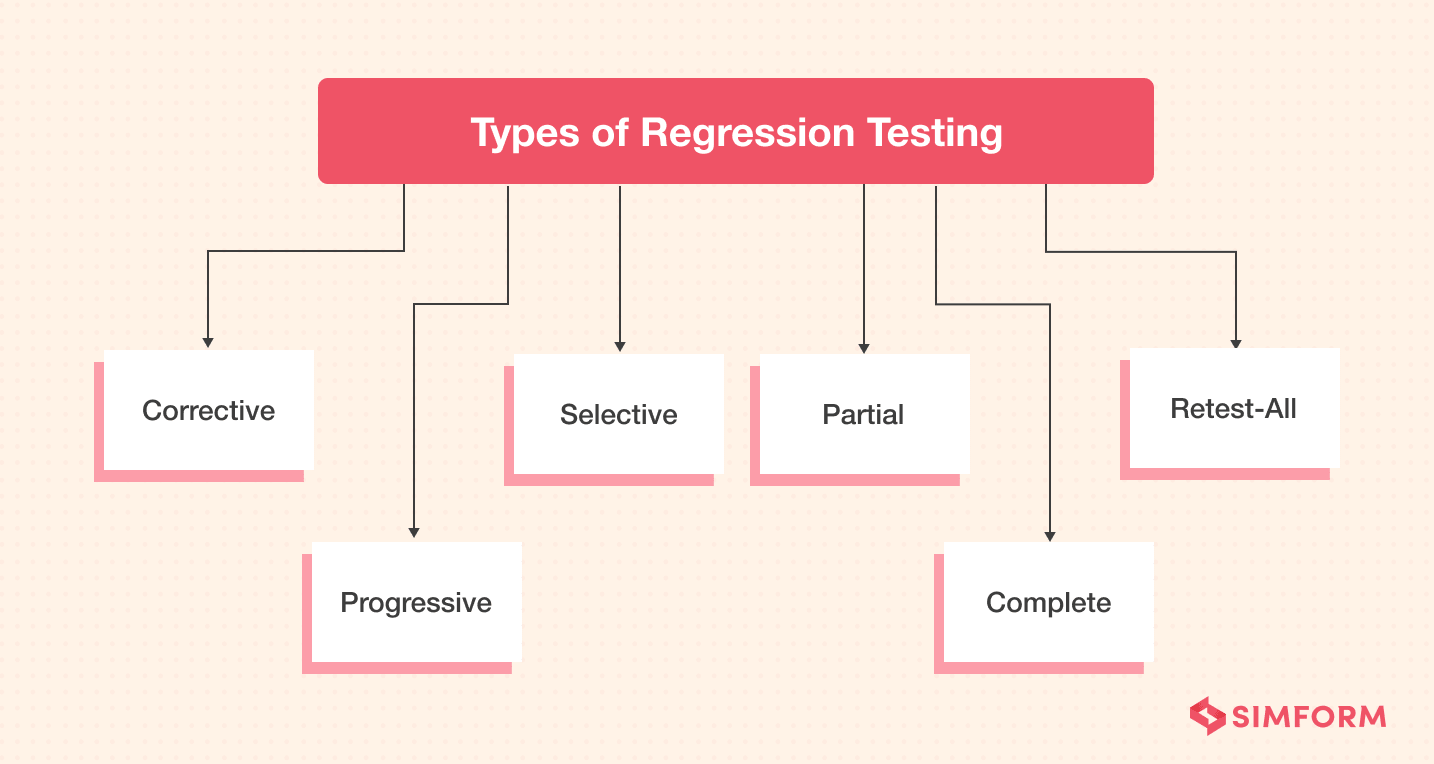
1. Corrective
Corrective regression testing is a suitable option when there is no change in your application’s source code. You want to check if the current system is working correctly, and therefore, you will test the existing functionalities and their related test cases instead of writing new ones.
2. Progressive
Progressive testing will be ideal for modifying the testing requirements and building new test cases. Generally, this testing type is preferred when introducing a new component into the system. This is because it helps you verify that changes do not adversely affect the old components.
3. Selective
As the name suggests, in selective testing, the test coverage is limited to a selected group of test cases already created. Thus, you test only a few chosen components instead of retesting the whole system.
4. Partial
Partial testing takes place to gauge the effect of adding new components to the system. For example, whether adding a new line to the source code would affect the system. Unlike selective testing, the new functionalities get tested alongside the old ones in this type. This way, you can analyze their impact.
5. Complete
This means testing the entire system at once. It is similar to acceptance testing to check whether the user experience gets compromised due to adding one or multiple modules. Complete testing is done just before the final release of the product.
6. Retest-All
The main idea of this testing is to re-execute all the test cases in the testing suite to make sure that there are no bugs due to a change in the source code of an application. This type of testing demands a lot of time and effort from the QA team compared to other types.
Now, you have an idea of the various regression testing services that the QA team can perform. However, in this day and age of automation, people rely on multiple tools for regression testing. So, let us analyze some of those tools in our next section.
Top Regression Testing Tools
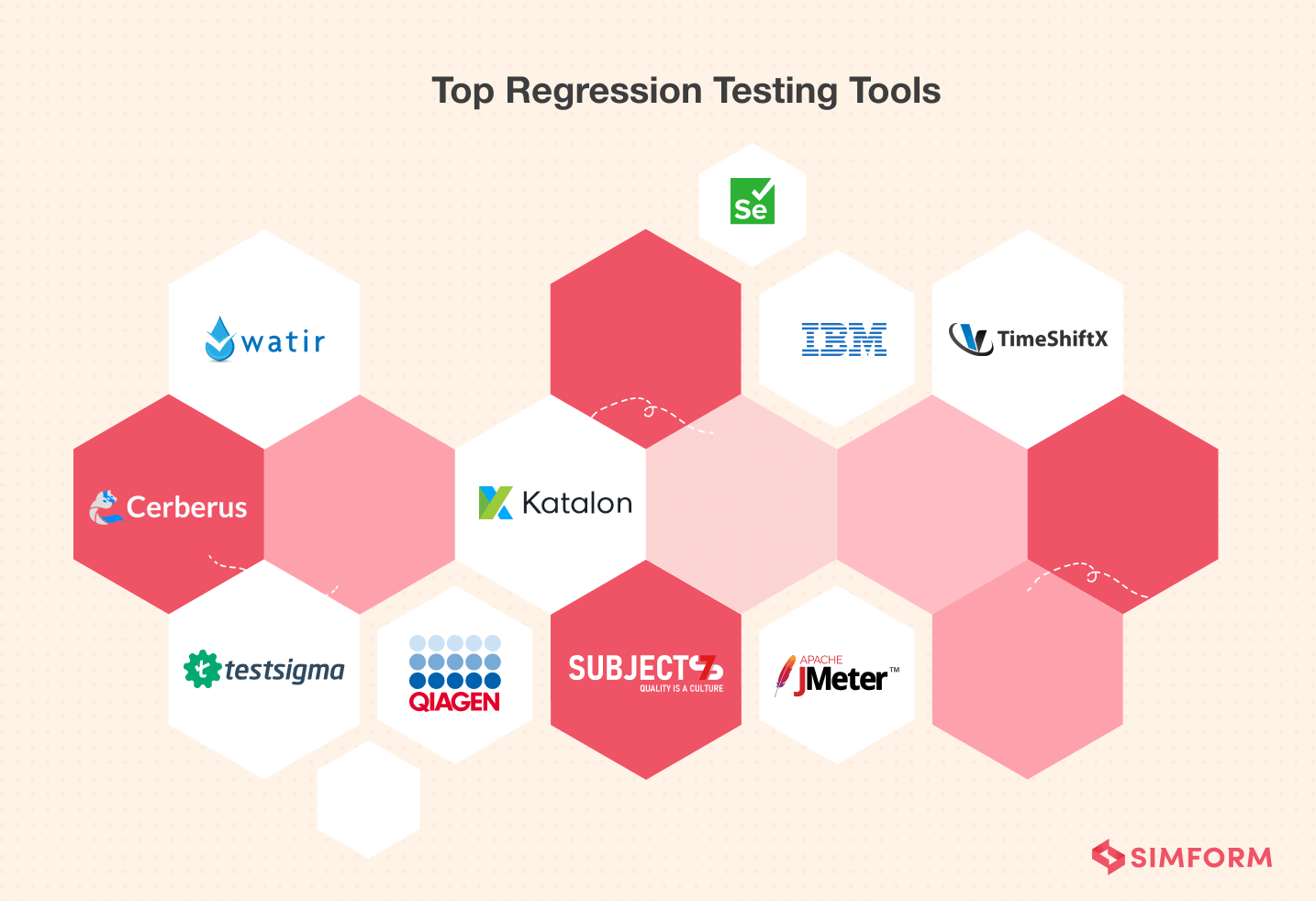
1. Selenium
Selenium is one of the finest regression testing softwares of you may have heard of. As a result, selenium is one of the first names that may strike your mind when it comes to browser-based or cross-platform regression testing. The tool provides automated test scripts through datasets and is highly suitable for large-scale quality assurance testing with knowledgeable testers.
2. Katalan Studio
Katalan Studio provides an end-to-end regression automation testing solution. It aims to make the testing process simpler and more accessible for novice testers. Katalan Studio is your one-stop solution for web services, web apps, and mobile app testing. Besides all these, the tool provides a facility for reporting and advanced analytics.
3. Watir
Watir is an open-source regression testing tool written in Ruby. With the help of this tool, testers can write a test case that is easy to read and understand. Also, Watir has a lightweight and flexible user interface. Besides all this, it offers interactive capabilities for website testing, and that’s why it is in massive demand.
4. IBM Rational Functional Tester
Rational Functional Tester or RFT is a testing automation tool created by IBM and supports various testing such as regression, functional testing, data-driven, etc. The tool is helpful for testing multiple applications such as web apps, .NET, Java, SAP, emulator-based apps, etc. Moreover, RFT simplifies the testing process for testers around the world.
5. Apache JMeter
Apache JMeter is an open-source regression test automation software created by Apache for measuring test case performance. The software is 100% written in the Java programming language. Some of the core features of JMeter are providing a load and performance tests facility, measuring service performance, and providing a regression testing suite for end users.
6. AdventNet QEngine
AdventNet QEngine is one of the most famous regression automation testing tools extensively used for web applications. The software is extensive, platform-independent, easy to use and understand. Furthermore, AdventNet QEngine provides multi-platform support to record scripts in Windows and then, replaying them in Linux.
7. Subject7
Subject7 is a widely utilized cloud-based, enterprise-level regression automation testing tool for desktop, web, and mobile applications. The tool supports high-scale parallel execution and is available for public, private, and hybrid cloud-ready apps. Whether you look at the tool from a technical or financial perspective, it stands out on both of these parameters.
8. TimeShiftX
TimeShiftX is one of the most innovative regression automation testing tools that the QA team will love to use. The USP of this tool helps companies gain a competitive advantage by making test cycles shorter and reducing resource requirements. Moreover, it allows firms to release the software quickly, which is why TimeShiftX is highly popular among testers.
9. Cerberus Testing
Cerberus Testing is a 100% open-source and regression testing automation tool supporting web, mobile APIs, which requires less coding and much more. The software is available in the cloud and easily accessible through a web interface and does not require high-end development skills. Reusable test modules and test data make this tool a preferred choice among testers.
10. Testsigma
Testsigma is one of the ideal automated testing tools utilized for regression testing. One good thing about this tool is that you have scriptless test cases created in plain English. In addition, this tool can support CI/CD workflows with Jenkins, JIRA, Slack, etc. Finally, Testsigma gives you the freedom to write custom functions and define prerequisites for regression test suites.
Knowing the tools for regression testing is just theoretical learning. However, you must know the best practices to follow while using regression testing tools to get the desired results. So, let’s focus on the best practices for regression testing.
Regression Testing Best Practices
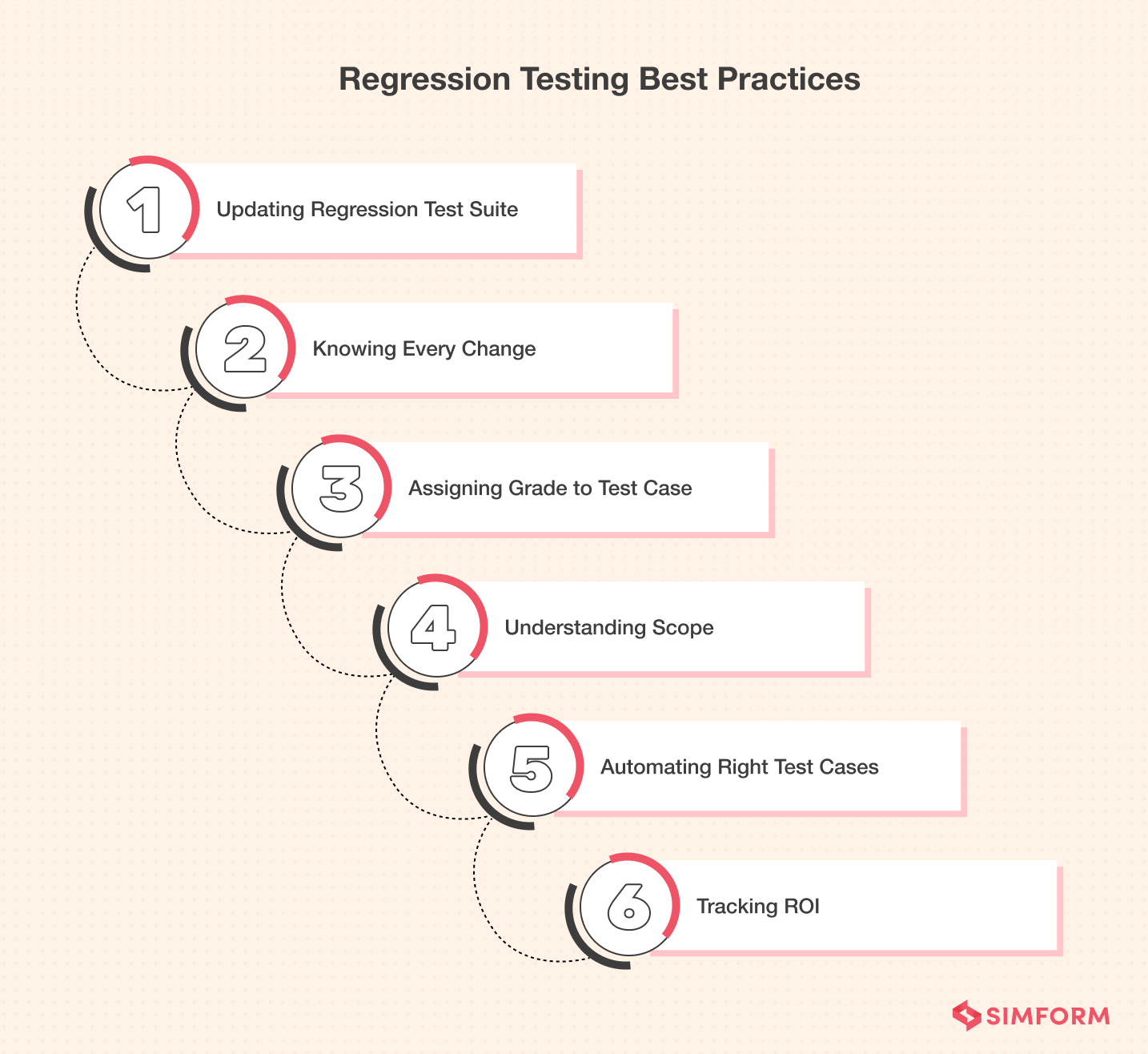
1. Keeping Up With Latest Regression Suite
Like keeping up with any technology, you must also stay up-to-date with the latest regression testing suites. For that purpose, always consider the functional and non-functional requirements. The suite’s high-priority and high-value test cases should always be executed by the QA team first.
2. Knowing Every Change Hands-on
If you’re someone associated with software development, you must know that change is the only constant here. So, having hands-on knowledge of every modification is necessary.
Regularly communicate with developers and testers to know the latest upgraded version and be aware of immediate changes. They can plan their testing well to stay on track with the app or product release.
3. Assigning Grade to Test Cases
If you want to succeed with regression testing, you need to assign grades to all your test cases. You should compare and track their business impact on different platforms, and based on those evaluations; you should set high, medium, and low priority to various test scenarios. This would help you understand, differentiate, and identify multiple roadblocks and conduct effective testing based on the requirements.
4. Understanding the Scope of Testing
Before starting the regression testing process, it’s essential to know its scope. The reason being each testing project can vary in terms of scope, time, and goals. Understanding differences in scope will allow you to plan your regression cycle execution better.
5. Automate the Right Test Cases
Automation gives you a competitive advantage only if you utilize it properly. So first, you need to identify which test cases you can automate and those that don’t have a scope of automation. Then, automating suitable test cases will increase your productivity and save precious time.
6. Track RoI
RoI is the most important parameter to judge the success of your regression testing campaign. QA teams should always track RoI based on the advanced analytics and reports generated by automation tools. It will help you witness the on-ground reality and areas needing improvement.
Now, You may have a hands-on idea about the best practices that QA managers should follow for regression testing. However, widely there is confusion between regression testing and retesting among many testing communities. So, let’s analyze the difference between them both in our next section.
Regression Testing vs. ReTesting
Most people believe that retesting and regression testing is the same. However, that is not true; both these terms have a separate meaning.
“Retesting” means testing again when the source code gets fixed, or a test case fails in the final execution. While “Regression Testing” means verifying that an update or change is not affecting the existing product functionality.
Here are some more differences between these two terms:
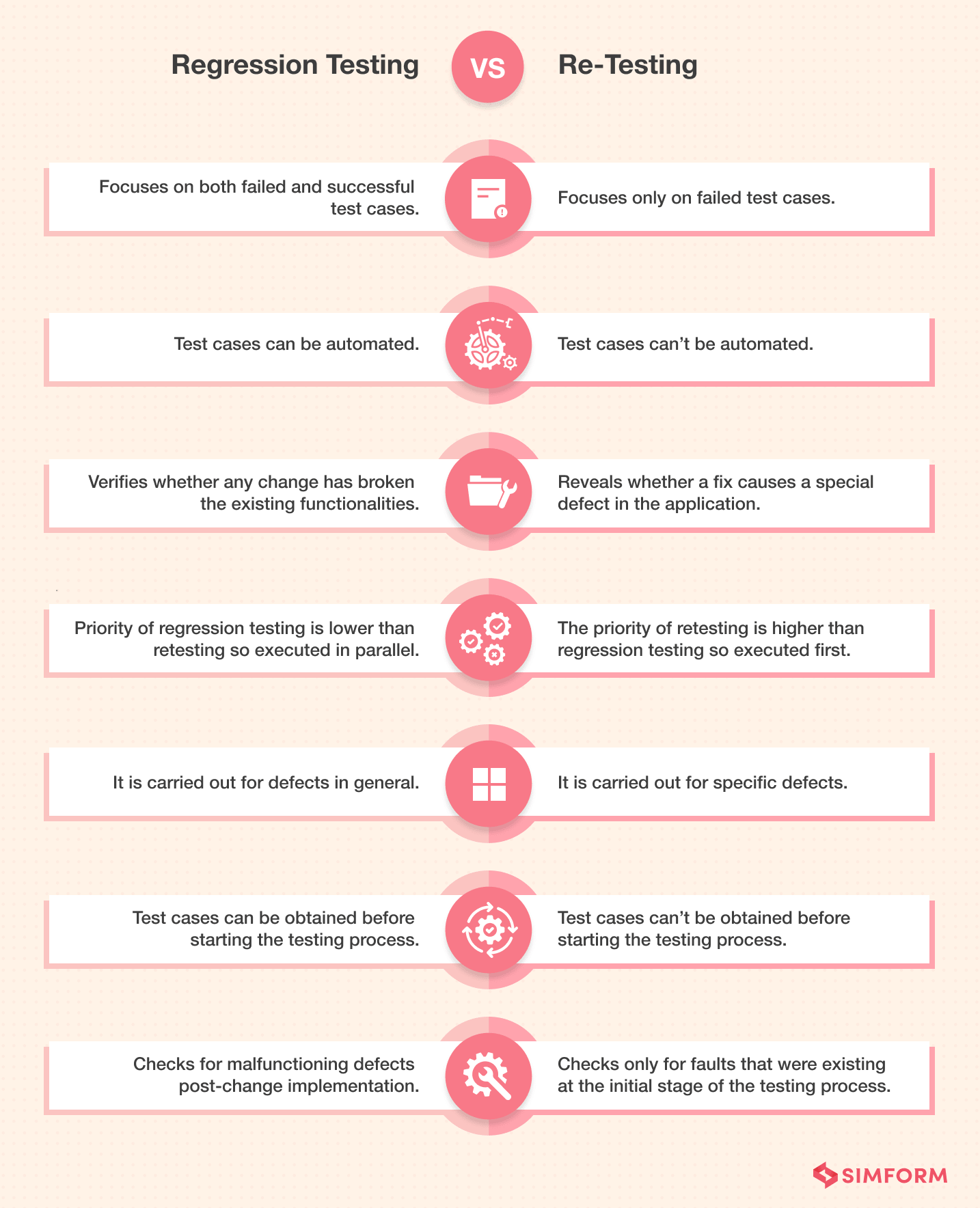
So far, we have analyzed regression testing 360 degrees from every possible angle. We have also understood its difference with retesting. Now, the only remaining thing is the role of regression testing in following agile methodology. When agile practices are the way forward, how can regression testing ensure no negative impact after coding changes? Here is your answer to it.
Regression Testing and Agile Methodology
As you know, the agile methodology relies on incremental and iterative approaches. You develop software or a product over short iterations called sprints. Several sprints mean several iterations and several iterations indicate a change in the source code, which may be an addition or an update with new features. That’s where the role of regression testing comes into the picture.
Agile teams should prepare the regression test suite from the initial stages of the product development cycle and then follow that until the final deployment. In agile methodology, you can conduct regression testing in two ways:
- Sprint Level Regression: You perform this type of regression to conduct an impact analysis of any new functionality added or upgraded in the latest sprint. For this purpose, you should select the test cases as per the new feature added to the product.
- End-to-End Regression: Here, you re-execute all the completed test cases to ensure that all the core functionalities of the product are working as expected.
The agile methodology involves short sprints; therefore, you must frequently perform regression testing. Now, if you perform this manually, it will become cumbersome for the QA experts. So instead of that, people take the assistance of automation for regression testing in an agile manner. It helps you to reduce the execution time and allows you to identify frequent defects too.
Summing Up Things
Few organizations ignored proper testing and faced fatal consequences. Here are the examples,
- In Jan 2012, Marks and Spencer accidentally priced their TVs at £199 instead of £1099.
- In Dec 2018, O2 released a software update that caused 30 million users to lose access to their data.
Organizations could have avoided these fatalities by conducting regression testing before updating or adding a new feature. From the above example, you must have realized the importance of regression testing in software testing in today’s times.
Regression testing becomes vital if you want to deliver high-quality and robust applications where users could be loyal. Taking those scenarios into consideration, in this article, we have provided you with a comprehensive view of regression testing, its types, tools, methods, and everything else you need to be aware of.
However, if you still want to know more about it or wish to conduct regression testing for your products, then connect with us today. We would be happy to guide you through the testing process with our expertise and make your development journey seamless.
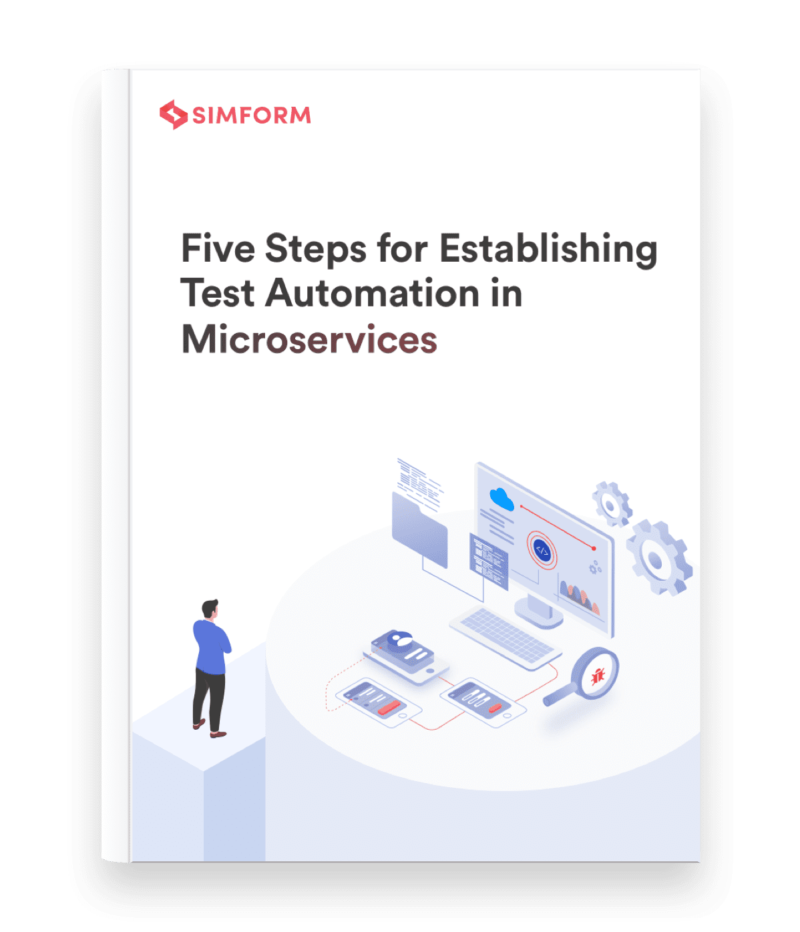
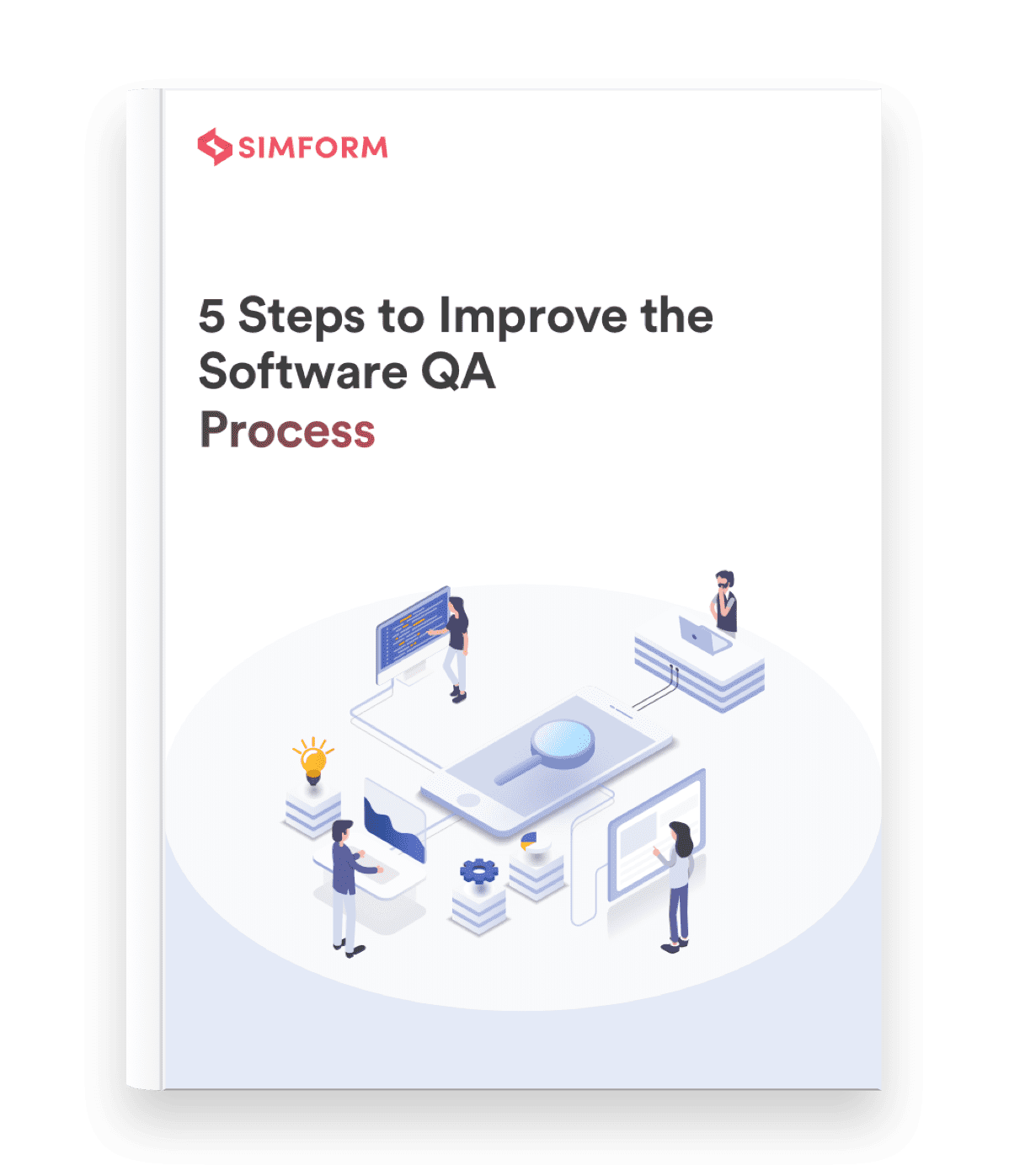
Venessa Serrao
Very well written and easily explained. Basic information about Regression Testing in a well-put manner. Thanks for Pondering.